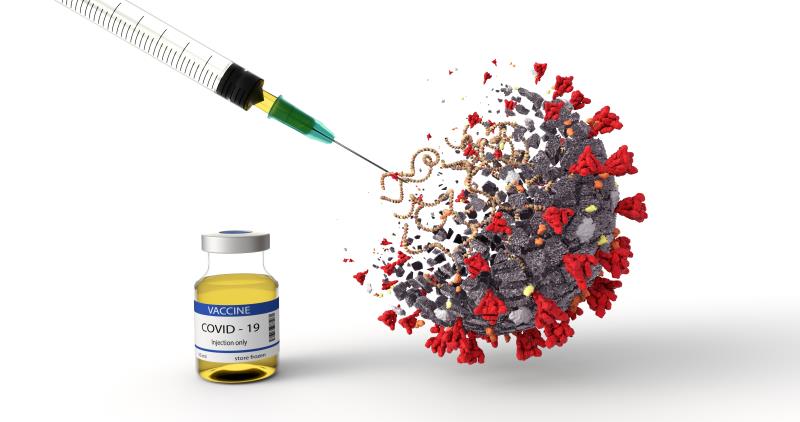Ad5 vectored COVID-19 vaccine shows potential in first-in-human trial





The novel Ad5 vectored COVID-19 (Ad5-nCoV) vaccine is safe, well-tolerated, and induces rapid immune response against SARS-CoV-2 in healthy adults, reveal data from the first-in-human trial for a COVID-19 vaccine.
Specific T-cell responses against SARS-CoV-2 were seen as soon as 14 days after a single vaccine shot, and specific humoral immunity peaked at 28 days — sparking hopes of a potential COVID-19 vaccine on the horizon.
“These results represent an important milestone. The trial demonstrates that a single dose of the new Ad5-nCoV vaccine produces virus-specific antibodies and T cells in 14 days, making it a potential candidate for further investigation,” said principal investigator Professor Chen Wei from the Beijing Institute of Biotechnology, Beijing, China.
Nonetheless, the researchers were cautiously optimistic on what the data mean for a working vaccine against SARS-CoV-2.
“These results should be interpreted cautiously. The challenges in the development of a COVID-19 vaccine are unprecedented, and the ability to trigger these immune responses does not necessarily indicate that the vaccine will protect humans from COVID-19,” he cautioned.
“This result shows a promising vision for the development of COVID-19 vaccines, but we are still a long way from this vaccine being available to all.”
A first step
Ad5-nCoV vaccine, the first COVID-19 vaccine to enter a phase I trial, consists of the adenovirus type-5 vector which codes for the spike glycoprotein of SARS-CoV-2.
Participants in the open-label, dose-escalation, phase I trial were 108 healthy adult volunteers aged 18–60 years (mean age 36.3 years, 51 percent male) who received an intramuscular injection of one of three doses of the Ad5-nCoV vaccine: high dose (5x10¹⁰ viral particles; n=36), middle dose (1x10¹¹ viral particles; n=36), and low dose (1.5x10¹¹ viral particles; n=36). [Lancet 2020;395:1845-1854]
Regardless of the dosage used, the vaccine was able to trigger both arms of the immune system: the humoral immunity, which entails the production of neutralising antibodies, and the cell-mediated immunity involving T cell-mediated response.
By 14 days post-vaccination, specific binding antibodies against the virus (measured using ELISA) were detected across all three groups in a dose-dependent manner: 44 percent, 50 percent, and 61 percent in the low-, medium-, and high-dose groups, respectively. Similarly, neutralising antibodies were detectable in 28 percent, 31 percent, and 42 percent of the participants, respectively.
The increase in antibodies was significant by day 14, and the response reached its peak at 28 days post-vaccination — most recipients (97 pecent, 94 percent, and 100 percent in the low-, medium-, and high-dose groups, respectively) saw a fourfold rise in binding antibodies against SARS-CoV-2.
Also, specific T-cell response peaked in the majority of recipients 14 days after vaccination, with greater levels seen with higher doses (83.3 percent, 97.2 percent, and 97.2 percent in the low-, medium-, and high-dose groups, respectively).
“Onset of detectable immune responses was rapid, with T-cell responses peaking at day 14 after vaccination and antibodies peaking at day 28,” Chen and co-authors noted.
“Although we found that the high-dose vaccine tended to be more immunogenic than the middle-dose and low-dose vaccines, it was also associated with a higher reactogenicity,” they added. “Severe fever, fatigue, dyspnoea, muscle pain, and joint pain were reported in some of the recipients in the high-dose group.”
As such, the researchers have chosen the low and middle doses for further study in the phase II trial.
Well tolerated
Adverse events (AEs) occurring within 7 days post-vaccination were reported in 83 percent, 83 percent, and 75 percent of the recipients of low-, middle-, and high-dose vaccine, respectively. Nonetheless, most AEs were mild or moderate, according to the researchers.
The most common injection site AE was pain, experienced by 54 percent of participants, whereas the most commonly reported systematic AEs included fever (46 percent), fatigue (44 percent), headache (39 percent), and muscle pain (17 percent).
There was no serious AE within 28 days of vaccination.
“Our study suggests that there is potential for further investigation of the Ad5 vectored COVID-19 vaccine for prevention of COVID-19,” said Chen and co-authors.
However, whether the specific antibodies or T cells confer effective protection is not yet known, noted the researchers. “Therefore, we are unable to predict the protection of the Ad5 vectored COVID-19 vaccine on the basis of the vaccine-elicited immune responses in this study.”
Also, both the humoral and T-cell response were stifled when there was high pre-existing immunity to adenovirus type 5 — a vector also carried by the common cold virus.
“Our study found that pre-existing Ad5 immunity could slow down the rapid immune responses to SARS-CoV-2 and also lower the peaking level of the responses. Moreover, high pre-existing Ad5 immunity may also have a negative impact on the persistence of the vaccine-elicited immune responses,” said lead author Professor Zhu Feng-Cai from Jiangsu Provincial Center for Disease Control and Prevention in Nanjing, China.
The researchers will continue to follow up on the participants for at least 6 months, and suggested further trials to find out if the immune responses elicited confer a protection against SARS-CoV-2 infection.